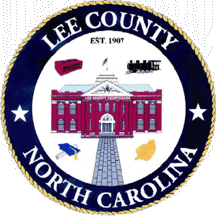LEE COUNTY GOVERNMENT:
leecountync.gov
COUNTY SEAT: Sanford
FORMED: 1907
FORMED FROM: Moore, Chatham
LAND AREA: 254.96 square miles
2020 POPULATION ESTIMATE: 63,285
White: 74.7%
Black/African American: 20.0%
American Indian: 1.3%
Asian: 1.4%
Pacific Islander: 0.2%
Two or more races: 2.4%
Hispanic/Latino: 19.6% (of any race)
From State & County QuickFacts, US Census Bureau, 2020.
CONGRESSIONAL DISTRICT: 6TH
BIOGRAPHIES FOR![]()
Lee County
 WILDLIFE PROFILES FOR
WILDLIFE PROFILES FOR
Piedmont region
GEOGRAPHIC INFORMATION
REGION: Piedmont though some parts are technically in the Coastal Plain
RIVER BASIN: Cape Fear, Map
NEIGHBORING COUNTIES: Chatham, Harnett, Moore

See also: Brick Making.
Lee County, located in North Carolina's Piedmont region, was formed from Moore and Chatham Counties in 1907 and took its name from Confederate general Robert E. Lee. Sanford (incorporated in 1874) became the county seat; other Lee County communities include Broadway, Northview, Cumnock, Tramway, Lemon Springs, Swann, and Colon.
Although it was one of the last of North Carolina's counties to be established, the area that became Lee County had long since demonstrated its importance to the state's economy and well-being. During the American Revolution, the Wilcox Iron Works supplied iron goods for North Carolina's war effort. In 1855 the first commercial coal mine in the state, Egypt Mine, was opened in the county; it too served the state's needs in time of conflict, supplying coal to blockade-runners during the Civil War. Lee County's most important manufactured products, today as well as historically, are bricks. Sanford has traditionally been regarded as the nation's "brick making capital," having produced more bricks than any other city in the United States. In 2002 the city also hosted the first Sanford Pottery Festival to celebrate the state's pottery-making heritage. While the Seagrove Pottery Festival in neighboring Randolph County is older, the Sanford festival quickly established itself as the largest pottery festival in the state. In 2004 Lee County's estimated population was slightly more than 50,000.
Annotated history of Lee County's formation:
For an annotated history of the county's formation, with the laws affecting the county, boundary lines and changes, and other origin information, visit these references in The Formation of the North Carolina Counties (Corbitt, 2000), available online at North Carolina Digital Collections (note, there may be additional items of interest for the county not listed here):
County formation history: https://digital.ncdcr.gov/Documents/Detail/the-formation-of-the-north-ca...
Index entry for the county: https://digital.ncdcr.gov/Documents/Detail/the-formation-of-the-north-ca...
References:
J. Daniel Pezzoni, The History and Architecture of Lee County, North Carolina (1995).
Additional resources:
Corbitt, David Leroy. 2000. The formation of the North Carolina counties, 1663-1943. https://digital.ncdcr.gov/Documents/Detail/the-formation-of-the-north-carolina-counties-1663-1943/3692099?item=4553233 (accessed June 20, 2017).
Lee County Government: https://leecountync.gov/
Sanford Area Chamber of Commerce: https://www.sanford-nc.com/
DigitalNC, Lee County: https://www.digitalnc.org/counties/lee-county/
North Carolina Digital Collections (explore by place, time period, format): https://digital.ncdcr.gov
Image credits:
Rudersdorf, Amy. 2010. "NC County Maps." Government & Heritage Library, State Library of North Carolina.
1 January 2006 | Vocci, Robert Blair
